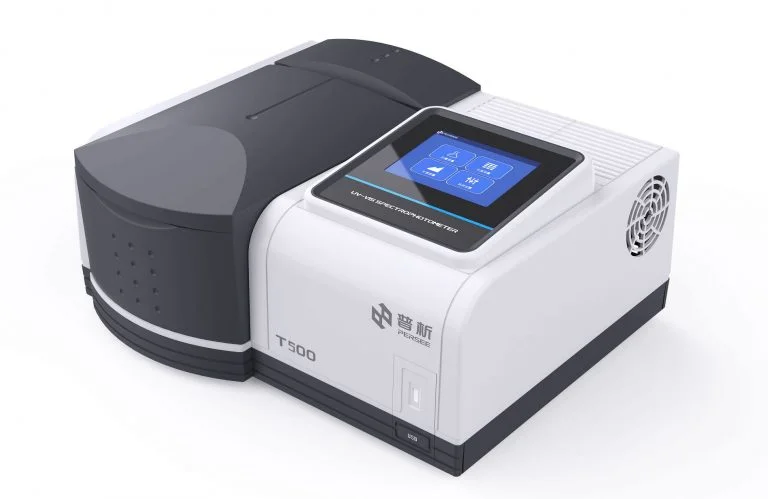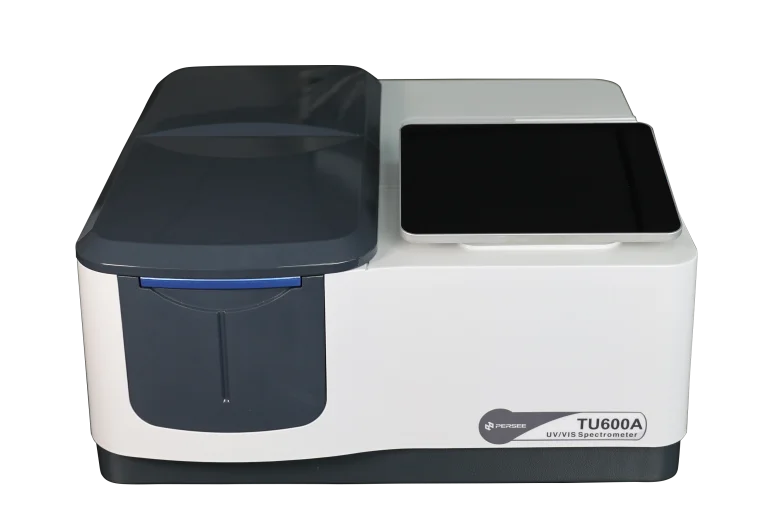Figuring out what stuff is made of is super important for scientists, lab workers, and people in different jobs. UV-Vis Spectrophotometers are awesome tools that check how materials soak up or let through light. They give clear ideas about what things are made of and how much is there. At PERSEE, we make great tools to help labs all over the world get correct answers easily. This blog talks about the basics, parts, uses, and things to think about with UV-Vis spectrophotometry. It also shows how our cool tools help lots of industries.

Basics of UV-Vis Spectrophotometry
UV-Vis spectrophotometry is a big part of science work because it’s simple and works well. It measures how light in the ultraviolet and visible range gets soaked up. This helps find and count stuff in samples. Let’s look at the main ideas behind this tool.
What is UV-Vis Spectrophotometry?
UV-Vis spectrophotometry is a way to measure how much ultraviolet (UV) and visible light a sample soaks up or lets through, usually between 190 and 1100 nm. It helps figure out the amount, purity, or traits of things like organic stuff, proteins, or metals. It’s popular in labs because it doesn’t harm samples and gives quick answers. This makes it great for science, medicine, and nature studies.
The Principles Behind UV-Vis Spectrophotometry
This method uses a rule called the Beer-Lambert Law. It says that how much light a sample soaks up depends on how much stuff is in it and how far the light travels through it. When light goes through a sample, bits inside soak up certain colors, making electrons move. The tool measures this to make a picture that shows what the sample is like. This rule makes UV-Vis super helpful for checking what’s in stuff and how much.
Knowing these ideas helps us understand the parts that make UV-Vis spectrophotometers work so well.
Components of a UV-Vis Spectrophotometer
A UV-Vis spectrophotometer is a fancy system with important pieces that team up to give right measurements. Each piece has a special job to make sure the data is good. Let’s check out these key parts.
Light Source and Its Role in Measurement
The light source sends out UV and visible light. It usually uses deuterium lamps for UV light (190–400 nm) and tungsten-halogen lamps for visible light (400–1100 nm). These give a steady stream of light to check many colors. A strong light source is super important for getting the same results every time.
Monochromators and Wavelength Selection
The monochromator picks out one color of light to send to the sample. It uses prisms or gratings to choose exact colors. This makes sure only the right light hits the sample. This careful picking is key for getting good measurements and clear pictures.
Sample Holders and Their Importance
Sample holders, often called cuvettes, hold the sample while it’s checked. They’re made of stuff like quartz or glass that doesn’t soak up much light. Good cuvettes stop light from scattering. Their quality is really important for right answers, especially when checking tiny amounts or lots of samples at once.
Detectors and Data Collection
Detectors, like photodiodes or photomultiplier tubes, catch the light after it goes through the sample. They turn light into electric signals. These signals make a picture of how much light was soaked up. Modern detectors are really good at spotting even tiny amounts of stuff in samples.
| Part | Job |
| Light Source | Sends out UV and visible light |
| Monochromator | Picks one color of light |
| Sample Holder | Holds the sample without messing up light |
| Detector | Turns light into data for pictures |
These parts work together to let UV-Vis tools do lots of jobs, which we’ll talk about next.
Applications of UV-Vis Spectrophotometers
UV-Vis spectrophotometers are super useful in many fields, from labs to quality checks. They give fast and right answers, making them a must-have. Here are some big ways they’re used.
Use in Chemical Analysis
In science work, UV-Vis spectrophotometry finds and counts stuff like organic bits or metals. It helps study how things react, check what they’re made of, and make sure they’re pure. For example, it can measure colored stuff in liquids to check if chemical products are good.
Role in Pharmaceutical Research
In medicine making, UV-Vis spectrophotometers make sure drugs are safe and work well. They count the main parts of drugs, find tiny mistakes, and check how fast pills dissolve. By looking at light pictures, scientists can make sure drugs are what they’re supposed to be. Our T6U spectrophotometer is built to give exact answers for these important jobs.
Applications in Environmental Monitoring
UV-Vis spectrophotometry helps a lot in nature studies. It checks water and air quality by finding bad stuff like nitrates or organic junk. For example, it can measure leftover chlorine in drinking water to make sure it’s safe. Its ability to work in the field and spot tiny bits makes it great for nature work.
These uses show how helpful UV-Vis tools are, but what are their good and not-so-good points?
Benefits and Limitations of Using UV-Vis Spectrophotometers
UV-Vis spectrophotometry has big benefits, but it also has some challenges. Knowing both helps labs decide how to use it best.
Advantages of UV-Vis Technology
UV-Vis tools are loved for being easy, quick, and useful in many ways. Here are their best points:
High Sensitivity and Accuracy
UV-Vis tools can spot tiny amounts of stuff, even in super small amounts. They give really exact answers. This is great for checking things like DNA, proteins, or tiny bits of bad stuff in nature.
Versatility Across Industries
From medicine to food testing, UV-Vis tools work with all kinds of samples, like liquids, solids, or gases with the right extras. This makes them super popular in school labs, work labs, and nature studies.
Common Challenges and Limitations
Even with their strengths, UV-Vis tools have some issues:
- Light Scattering: Bits floating in samples or bubbles can mess up light, causing wrong answers.
- Interference: When lots of stuff soaks up light in the same way, it’s hard to tell them apart. Samples may need to be separated first.
- Outside Problems: Extra light or dirt in the lab can mess up results, so a clean space is needed.
These points help labs pick the right UV-Vis tool for their work.

Factors to Consider When Choosing a UV-Vis Spectrophotometer
Picking the best UV-Vis spectrophotometer means thinking about what your lab needs. Important things make sure the tool fits your goals.
Wavelength Range and Resolution Requirements
The range of light (like 190–1100 nm) and how clear the tool can see decide if it’s right for your job. For example, medicine labs might need UV tools, while nature labs need a bigger range. Our TU500-UV-VIS has a wide range for all kinds of needs.
Software Capabilities and Data Analysis Features
Modern UV-Vis tools come with easy software for handling data, like checking how things change over time or measuring many colors at once. Good software, like in our TU600-UV-VIS, helps meet strict rules for medicine labs.
Maintenance Needs and Durability
Keeping the tool clean and replacing parts like lamps keeps it working well. Strong designs mean less time fixing it. Look for tools that are easy to put together and tough for busy labs.
| Thing to Think About | Why It’s Important |
| Wavelength Range | Makes sure it works with your samples |
| Software Features | Makes data easy to use and follows rules |
| Maintenance | Keeps the tool working without breaks |
These ideas help labs choose tools that match their needs, and we at PERSEE are here to help.
PERSEE: A Trusted Supplier for UV-Vis Spectrophotometers
At PERSEE, we’ve worked for over 30 years to make awesome tools for labs everywhere. Since we started in 1991, we’ve become a trusted team, making smart spectrometry tools with a focus on quality and happy customers.
Overview of PERSEE’s Product Lineup
We have a big range of UV-Vis spectrophotometers made无疑点。 Our tools, like the TU500-UV-VIS and TU600-UV-VIS, are made for medicine, nature studies, and science work. With ISO9001, ISO14001, and CE marks, our tools are all about quality and trust.
High-Quality Instruments Tailored for Various Applications
Our tools work for things like checking DNA or testing water. They have fast scanning and easy-to-change settings. This makes them great for all kinds of samples.
Advanced Technology Integration for Enhanced Performance
We add cool tech, like sharp optics and easy software, to our tools. For example, the T6U scans super fast at 30,000 nm/min and works with tiny samples, perfect for busy labs.
For more info or to talk about your lab’s needs, contact us today.
Conclusion
UV-Vis spectrophotometers are super important tools that help science and work grow. They give quick, right, and safe answers for things like medicine, science, and nature studies. At PERSEE, we’re excited to make reliable, smart tools that open new doors. Whether you’re checking drug purity or water quality, our UV-Vis tools give the exact answers you need to do great.
Frequently Asked Questions (FAQs)
Q1 What is the primary use of a UV-Vis spectrophotometer?
A1 A UV-Vis spectrophotometer’s main job is to measure how much UV and visible light a sample soaks up or lets through. This helps find the amount, purity, or traits of stuff like DNA, proteins, or drugs. It’s used a lot in medicine, nature studies, and science work.
Q2 How does a UV-Vis spectrophotometer differ from other spectroscopic instruments?
A2 UV-Vis tools focus on UV and visible light (190–1100 nm) to check how stuff soaks up or lets through light. Unlike infrared tools, which look at vibrations, or NMR tools, which check atomic spins, UV-Vis is easier and faster. It’s great for measuring amounts of stuff like proteins or bad stuff in nature.
Q3 Can UV-Vis spectrophotometers be used for quantitative analysis?
A3 Yes, UV-Vis tools are awesome for counting stuff. Using the Beer-Lambert Law, they measure how much light is soaked up to find the amount of things like DNA, proteins, or drugs. They give really exact answers for these jobs.

